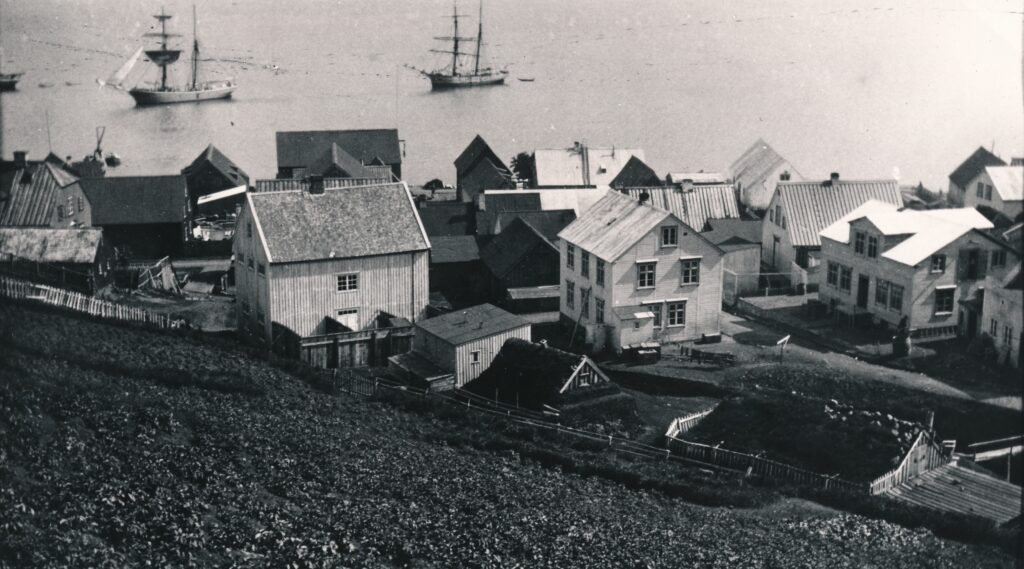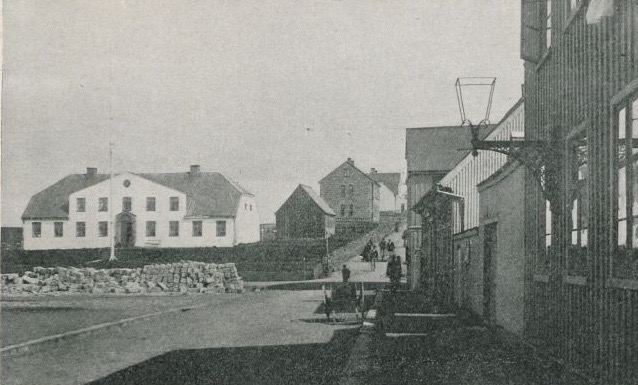
The prison in Akureyri is the tall building that has one window facing away from the harbour.
A prison was built in Akureyri in 1874 and was some sort of State Prison. It was managed by Sheriff of Eyjafjarðarsýsla and was to hold prisoners also from Húnavatnssýsla and Skagafjarðarsýsla. The main purpose was to safeguard the human rights of the imprisoned but also to keep them away from the general public.
Prisons more humane
The prison in Akureyri was one of seven that King Christian 9th ordered to be built in Iceland. The main reason: yes, to rid the Nation of floggings. Icelandic MPs as well as Danish officials considered such punishment most improper in civilized society. It had been a long time coming, it was not until 1867 that the idea finally was discussed in Iceland. The Althing needed to discuss a new bill concerning criminal law in Iceland and, as it was quite extensive, members asked for more time but to no avail. The Althing met every other year and operated only as an advisory committee. The King could not wait a year, the Icelandic Nation should have more humane criminal laws “according to the trend of time” than the previous law. And when the Althing met again in the summer of 1869, the new criminal law for Iceland was already in effect.
What Members of Parliament had most problem with was the amendment of the law abolishing the floggings, as flogging was much cheaper than imprisonment. Therefore, a regulation had been introduced in 1838 that three times 27 lashes equalled two years of penal labor. That lowered costs in the justice system in the country.
Hang them!
Way back in the 18th century, sheriffs thought they had found a way to cut the costs of imprisonment. The solution was simple: Hang all thieves – those who constantly steal, with the fourth offence, regardless of how insignificant they were – also those who break into shops and warehouses in the winter, and those who wander into the mountains and hills in order to steal livestock.
And this we want to control so executions can take place immediately was the demand sheriffs made, which stunned Danish authorities in the summer of 1757. The Danes were astonished to hear Icelandic authorities were prepared to hang all criminals, which did little to improve situations in the country where hunger and appalling housing had brought about deaths to 11% of the population in Iceland during 1756-1757. (One can add that the sufferings in Iceland worsened much more in the years to come.)
The response from Copenhagen was brief: Icelandic authorities would never get such power and a law was passed that no Icelandic citizen would be executed without the King’s consent.
Althing 1867
A century later Icelandic Members of Parliament faced a similar issue, i.e. saving costs in the justice system when they had to address the King´s new bill. The only prison in the country had been the penitentiary at Arnarhóll in Reykjavík which was closed in 1813. Twenty-five years later another prison was built in Reykjavík where inhabitants in the village who were jailed for criminal acts while their countrymen elsewhere in country were flogged for similar criminal offences.

The Government House on Arnarhóll was built 1761-1771 and was the State Prison. Later it became the home of the Governor of Iceland and here King Kristján IX of Denmark stayed during his visit to Iceland in 1874. Today it is the office of Iceland´s Prime Minister. Photo Nationalmuseet.
This new prison building in Reykjavík did not match the old penitentiary at Arnarhóll which later became the residence of the King´s highest representative in Iceland. The lawmakers had intended in 1838 to abolish the flogging; that sort of punishment would only be tolerated until proper prisons had been built. The fact remains that little, if anything, changed during the next decades and was the problem Members of Parliament faced in the Althing in 1867 when they had to consider the new criminal law the Danish King planned for Iceland.
It certainly has its advantages, the majority of the parliament committee maintained. The message of the law showed more “leniency and humanity which harmonizes with contemporary education, progress and liberal viewpoint”.
This was the opinion of all the twenty-seven Members of Parliament in the Althing. But this still was not sufficient for them, as they needed to know how the Icelanders could enjoy these more humane laws before prisons had been built. Authorities in Copenhagen had emphasized the importance of prisons in Iceland as the stipulation for the passing of the law.
The King responded two years later and introduced a new bill, dated March 4, 1871, regarding the construction of seven new prisons in Iceland.
The most deplorable
Once the new law was accepted, the most deplorable position in the history of Iceland was abandoned. In one of Jón Árnason’s collections of folk tales, a woman is attracted to a man who responds “There are not many eager to befriend me and too bad I have to refrain from this proposition”.
The man was a flogger and his answers above shows that it was almost as shameful to be a flogger as to be flogged. This was pointed out in 1866 by a committee in Iceland which the Danes had organized to review the bill on the new criminal law.
It was becoming increasingly difficult to find a man to be a flogger as more and more people in this country looked at the flogging as a very degrading position.
And the consequences?
This is easy, responded committee members “those prepared to become floggers are men of the lowest grade in the county and are looked upon as equals of those flogged and, therefore, suitable for the task on hand”.
But to rid Iceland off floggers was expensive as Ole Worm Smith, appointed sheriff for the North-East Territory, pointed out in his letter to the Ministry of Justice in Copenhagen in the winter of 1871.
It is preferable to have one prison per county in Iceland, but the cost will be much too high for the Icelanders who hardly can afford more taxes.
And it is much more expensive to imprison an individual for 5-6 days, for nothing more than bread and water, than to pay the flogger 2 Rigsdaler for flogging the guilty person, Smith pointed out. Nonetheless, he recommended two prisons in his district, one in Múlasýsla the other in Akureyri.
The above is based on research by the Icelandic Historian, Jón Hjaltason and his article “Tukthús og böðlar”. English version by Thor group
